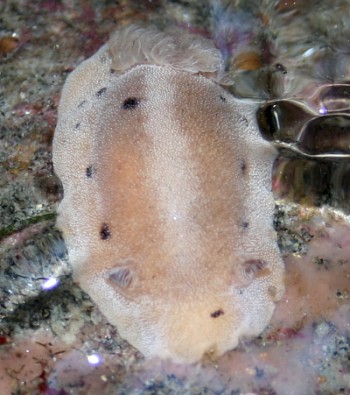
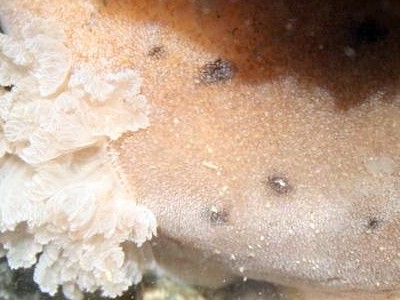
Alloiodoris lanuginata
(Abraham, 1877)
Order: NUDIBRANCHIA
Suborder: DORIDINA
Superfamily: EUDORIDOIDEA
Family: Dorididae
DISTRIBUTION
Endemic to New Zealand
PHOTO
Timaru, on the east coast of the South Island of New Zealand, 44.3774 S, 171.2497 E., 10 January 2008, Intertidal rock. Length: ~ 2 inches. Photographer: N Mieszkowska.
This is a relatively large dorid with a wide mantle skirt, growing to at least 8 cm in length. The mantle is covered is microscopic spiculate tubercules which makes the mantle surface quite rough to the touch. It varies from brown to a pinkish or whitish colour with scattered large brownish spots and smaller whitish ones. The translucent whitish gills are large and branched and the rhinophores are also pale in colour.
- Abraham, P. S. 1877. Revision of the anthobranchiate nudibranchiate Mollusca, with descriptions or notices of forty-one hitherto undescribed species. Proceedings of the Zoological Society of London pp. 196-269, pls. 27-30.
- Eliot, C. N. E. 1907a. Nudibranchs from New Zealand and the Falkland Islands. Proceedings of the Malacological Society of London 7(6):327-361, pl. 28.
- Willan, R. C., & Morton, J.E. 1984. Marine Molluscs part II - Opisthobranchia, pp. 1-106. University of Auckland, Leigh Marine Laboratory.
Rudman, W.B., 2010 (January 19) Alloiodoris lanuginata (Abraham, 1877). [In] Sea Slug Forum. Australian Museum, Sydney. Available from http://www.seaslugforum.net/find/allolanu
Related messages
Re: Paradoris from New Zealand
May 19, 2010
From: Nova Mieszkowska
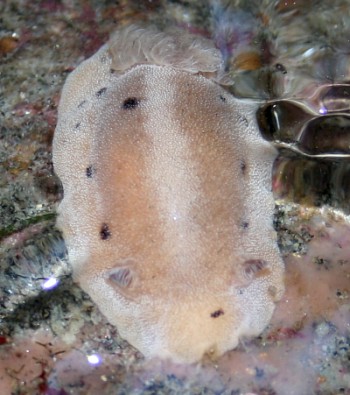
Concerning message #23082:
Dear Bill
Thank you so much for identifying the Paradoris and Aphelodoris for me. The Paradoris story is interesting, and I have found specimens at other locations too, including a white one, a more orangey one and another pink one in a boulderfield with a lot of biogenic reef in the lowshore at Cape Foulwind which I am assuming are all the same species (although these little beauties are not my speciality). I've attached pics of them all for you in case they are of any use.
These were taken as part of a national survey of rocky shores that I did around NZ in 2008/09 where I documented macoalgae and macroinverts to set down a baseline for future climate change research similar to the long-term time-series research which I already manage in the UK and northern Europe. Interestingly the seaslugs were some of the most difficult species to find good id guides for in NZ which is why your assistance is invaluable. I love reading the other posts and increasing my knowledge so thanks for the id's and for providing an educational and entertaining site.
Best wishes
Nova
Dr Nova Mieszkowska
MBA Research Fellow
Marine Biological Association of the UK
Plymouth, UK
nova@mba.ac.uk

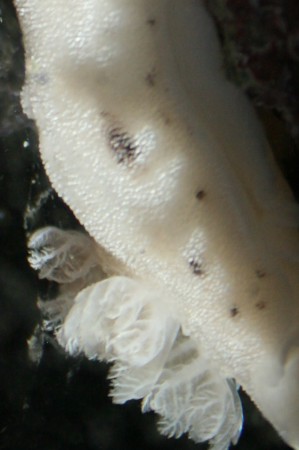
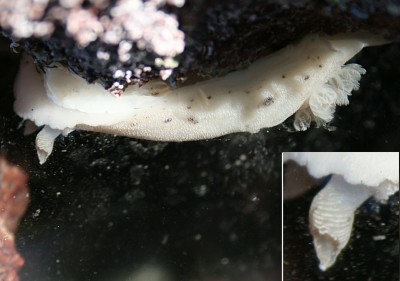
Dear Nova,
On reflection I am pretty sure this is Alloiodoris lanuginata, a quite common New Zealand endemic. Sorry for leading you astray earlier
Best wishes,
Bill Rudman
